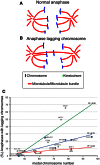Cancer karyotypes: survival of the fittest
- PMID: 23760367
- PMCID: PMC3675379
- DOI: 10.3389/fonc.2013.00148
Cancer karyotypes: survival of the fittest
Abstract
Cancer cells are typically characterized by complex karyotypes including both structural and numerical changes, with aneuploidy being a ubiquitous feature. It is becoming increasingly evident that aneuploidy per se can cause chromosome mis-segregation, which explains the higher rates of chromosome gain/loss observed in aneuploid cancer cells compared to normal diploid cells, a phenotype termed chromosomal instability (CIN). CIN can be caused by various mechanisms and results in extensive karyotypic heterogeneity within a cancer cell population. However, despite such karyotypic heterogeneity, cancer cells also display predominant karyotypic patterns. In this review we discuss the mechanisms of CIN, with particular emphasis on the role of aneuploidy on CIN. Further, we discuss the potential functional role of karyotypic patterns in cancer.
Keywords: CIN; aneuploidy; cancer; karyotype; selection.
Figures

References
-
- Adeyinka A., Mertens F., Idvall I., Bondeson L., Ingvar C., Heim S., et al. (1998). Cytogenetic findings in invasive breast carcinomas with prognostically favourable histology: a less complex karyotypic pattern? Int. J. Cancer 79, 361–36410.1002/(SICI)1097-0215(19980821)79:4<361::AID-IJC9>3.0.CO;2-T - DOI - PubMed
-
- Alberts B., Bray D., Lewis J., Raff M., Roberts K., Watson J. D. (2008). Molecular Biology of the Cell. New York: Garland Publishing, Inc
LinkOut - more resources
Full Text Sources
Other Literature Sources

